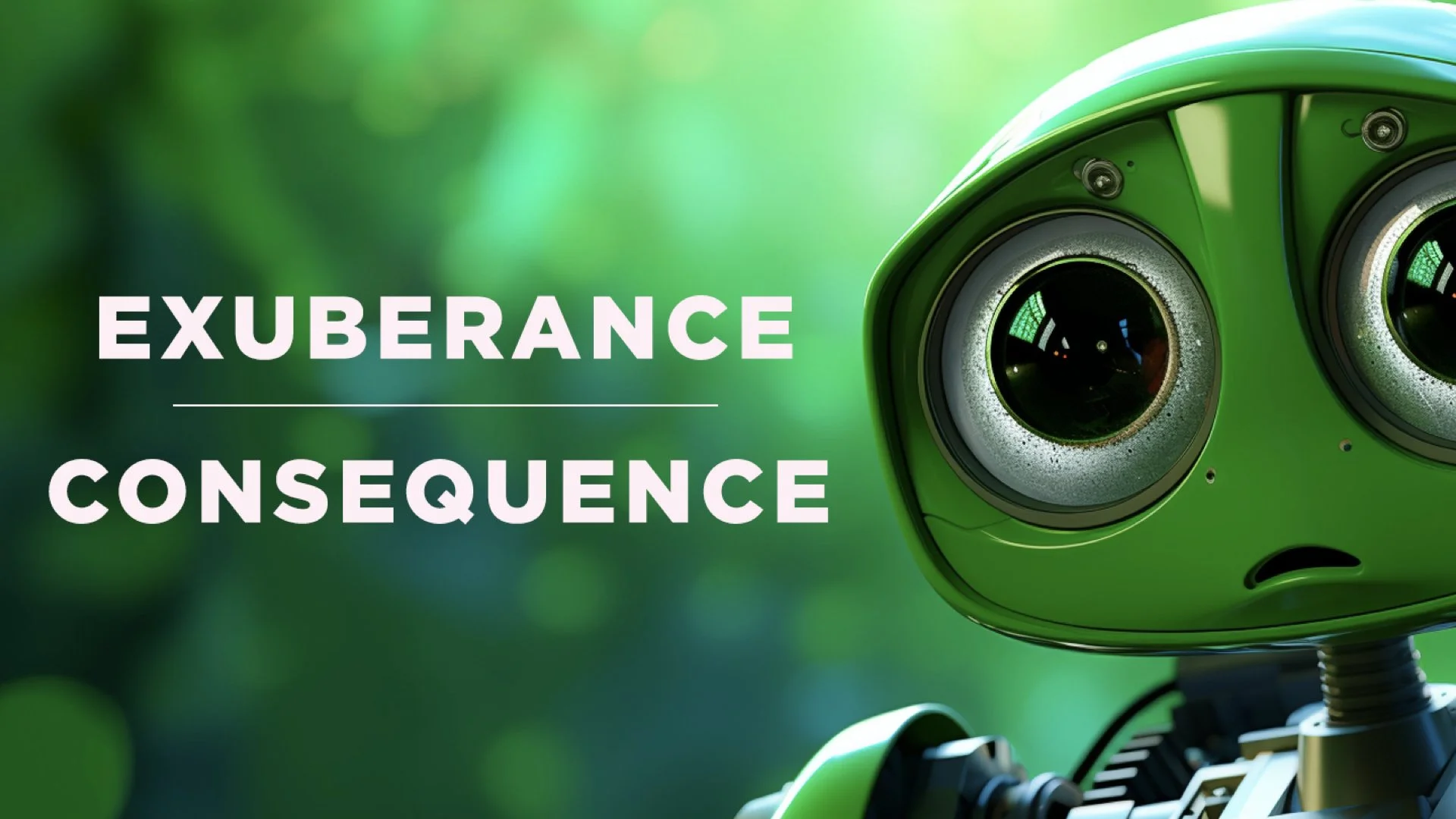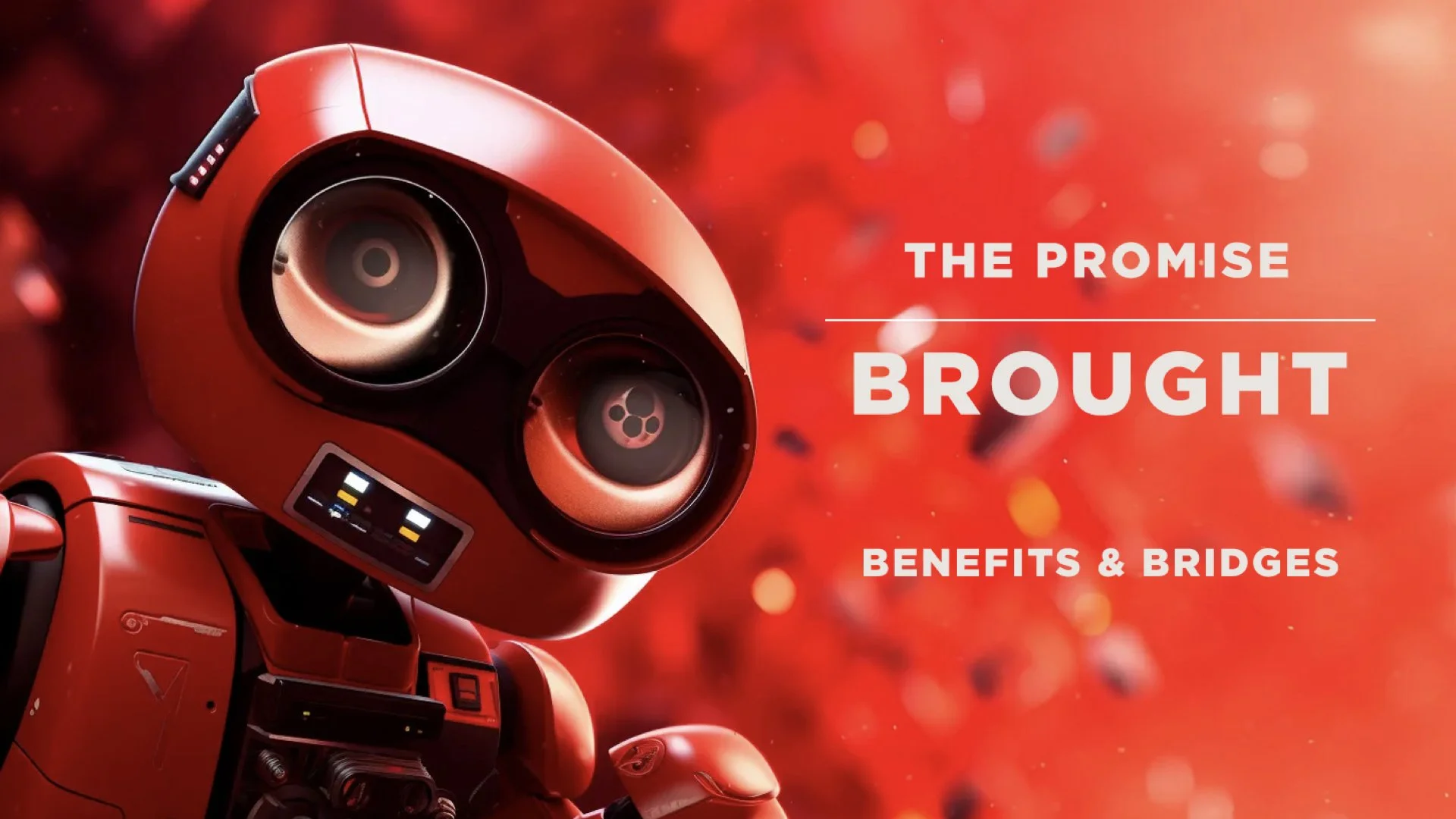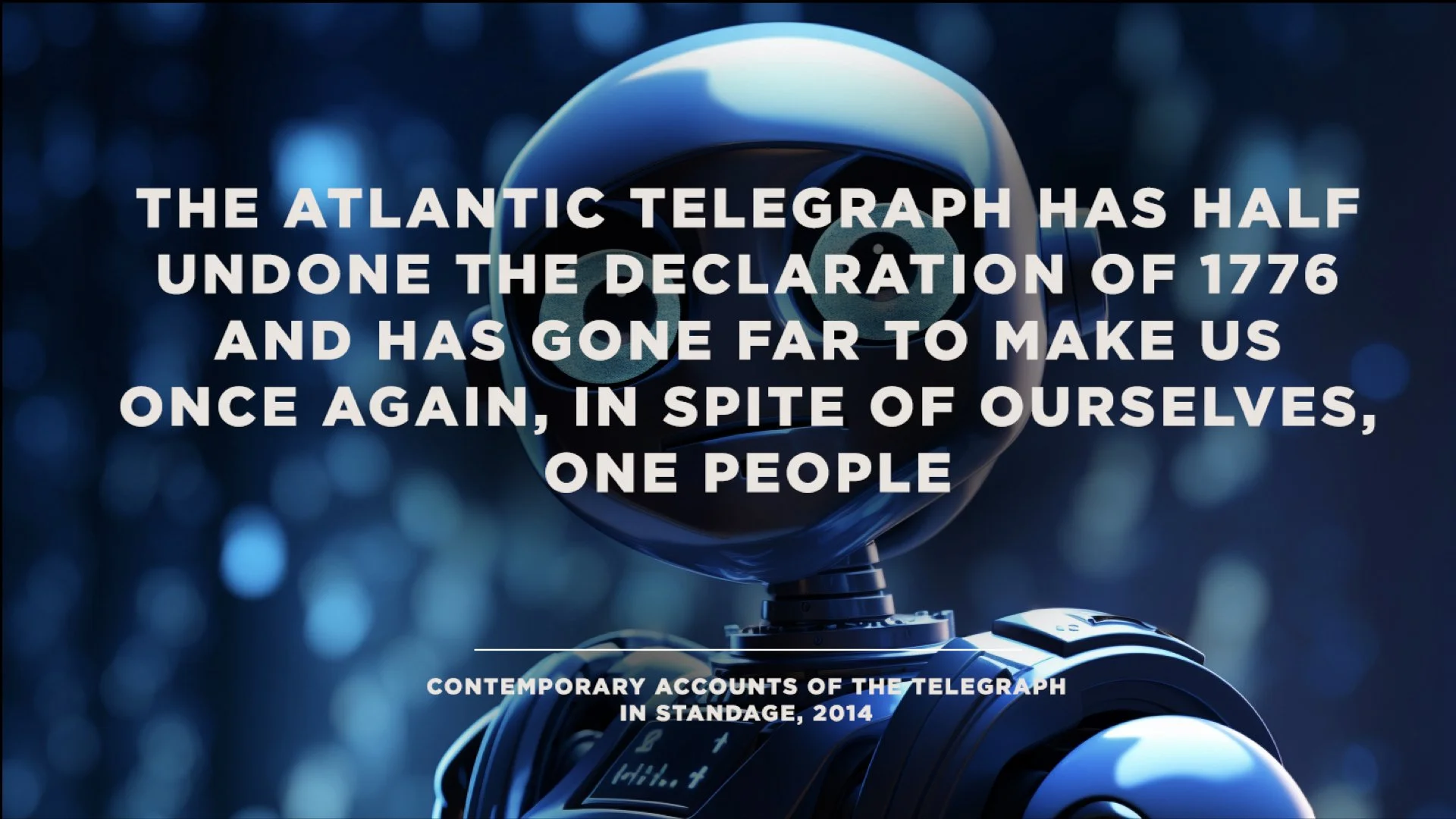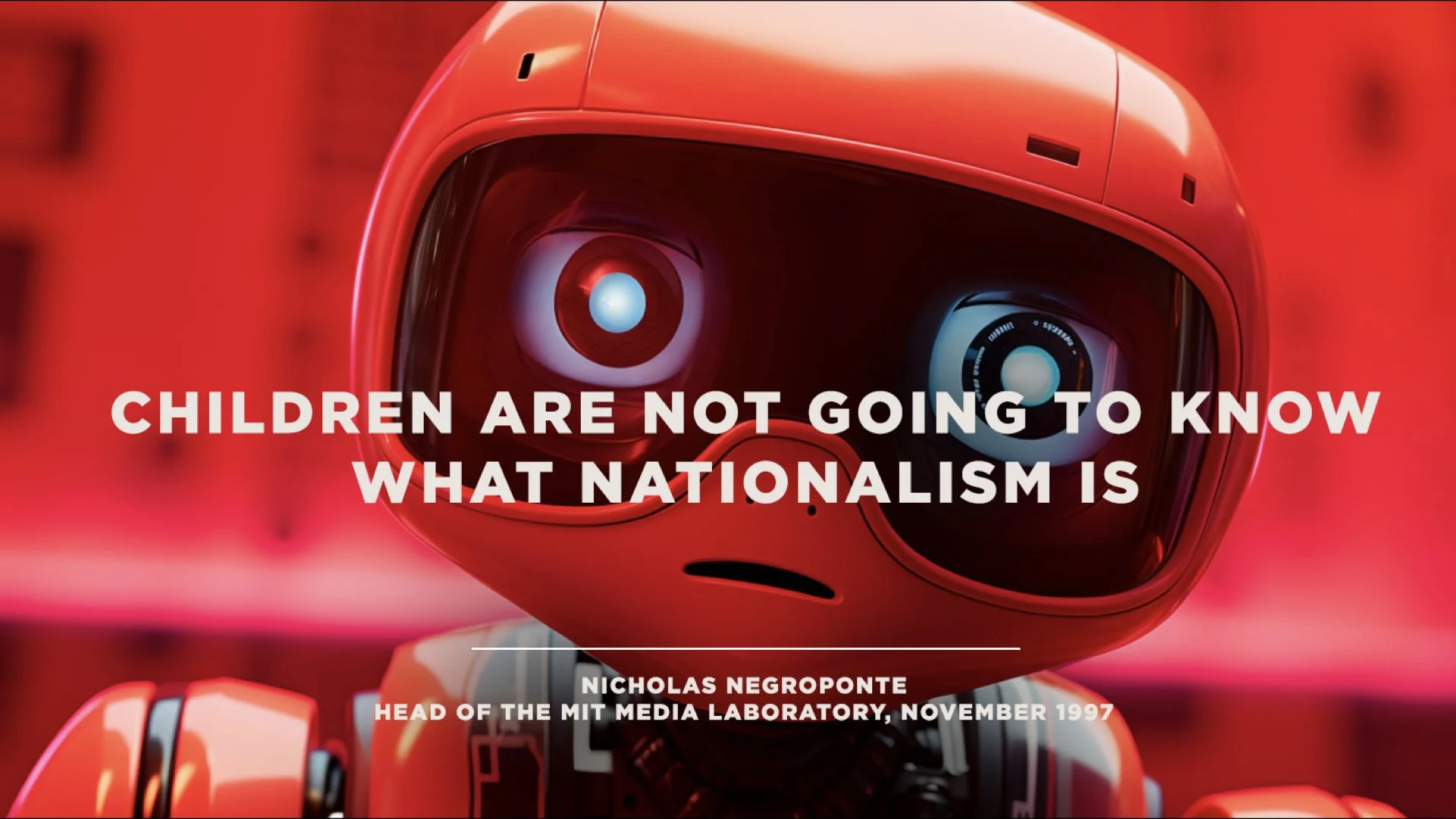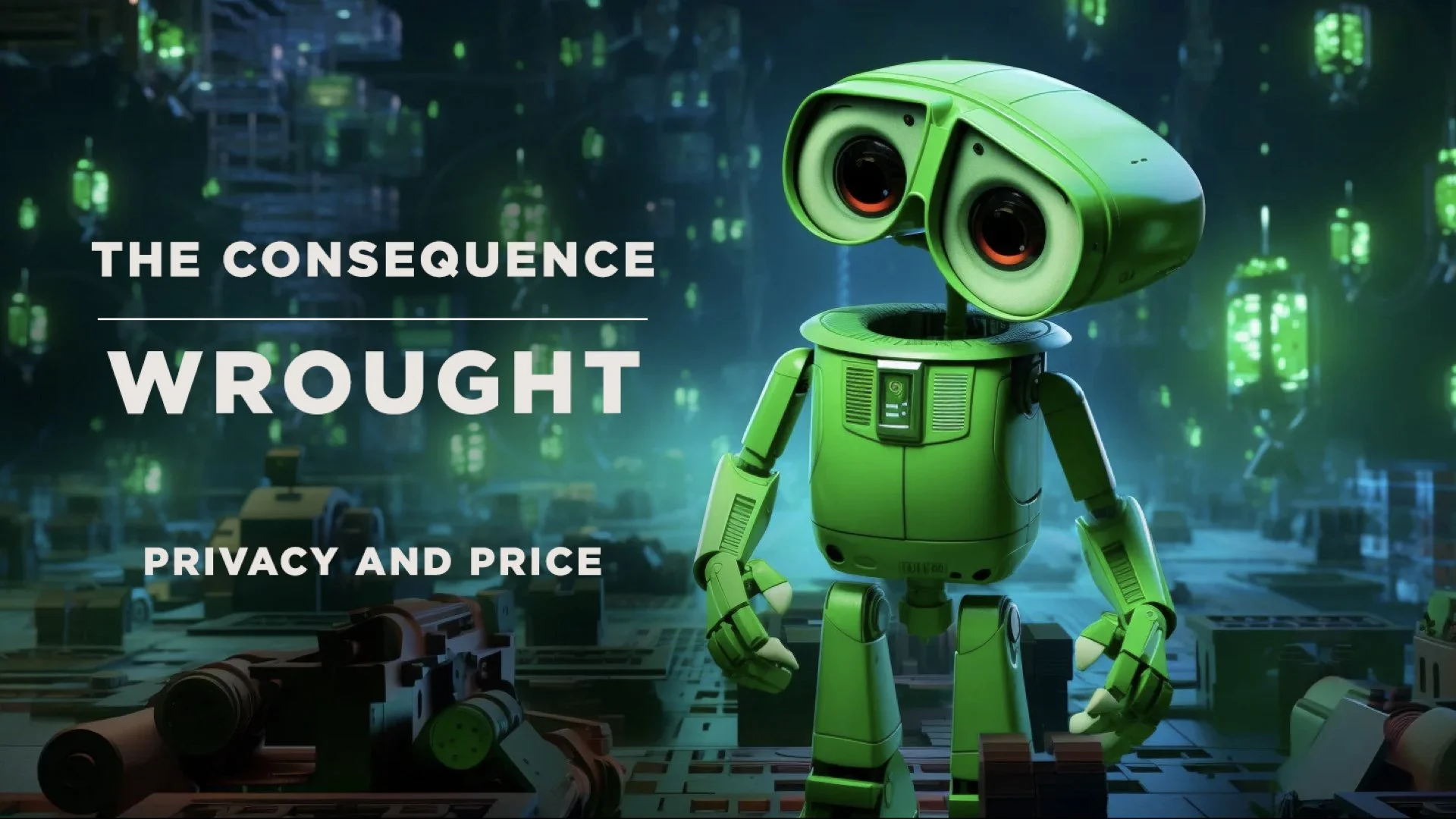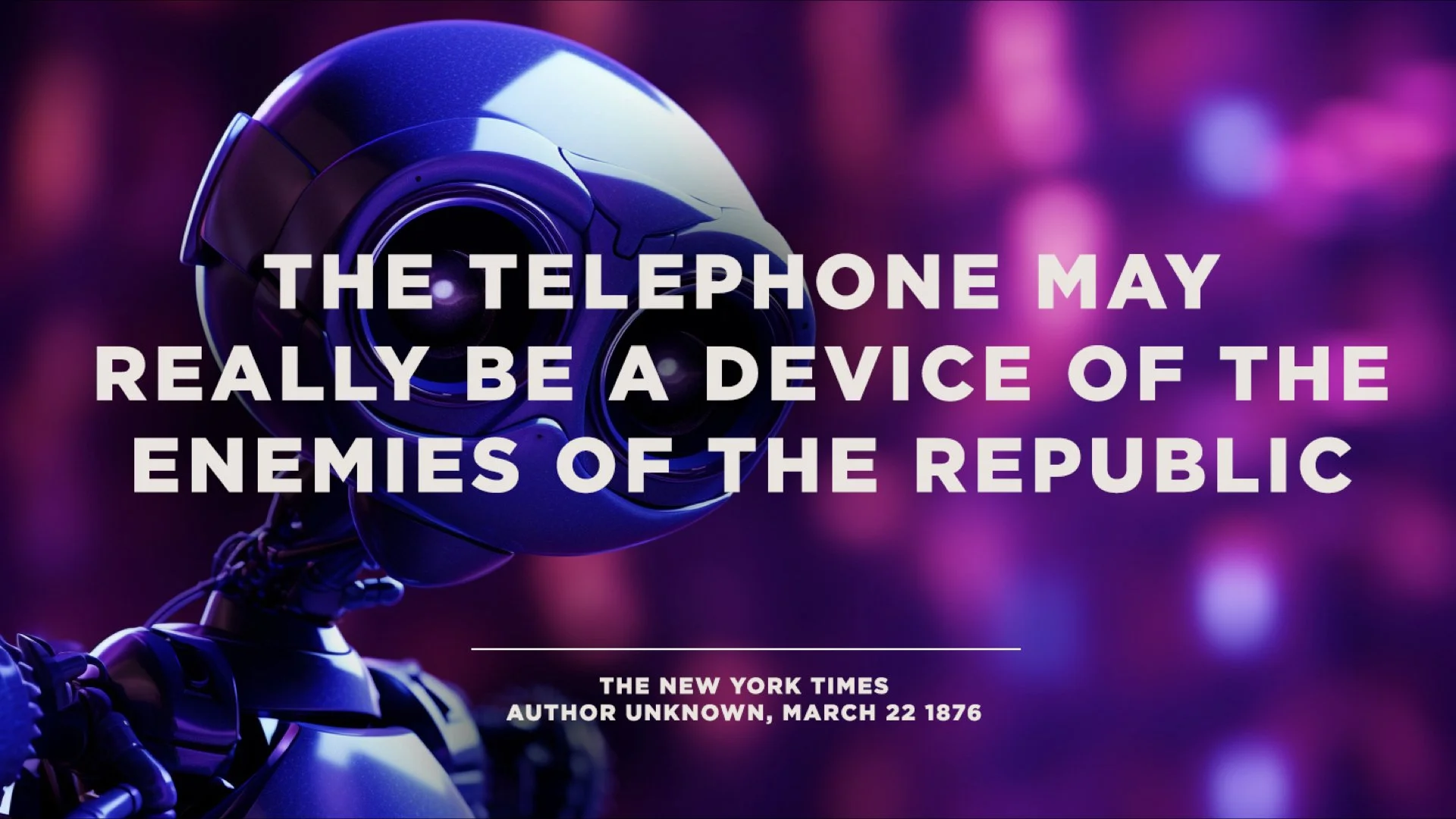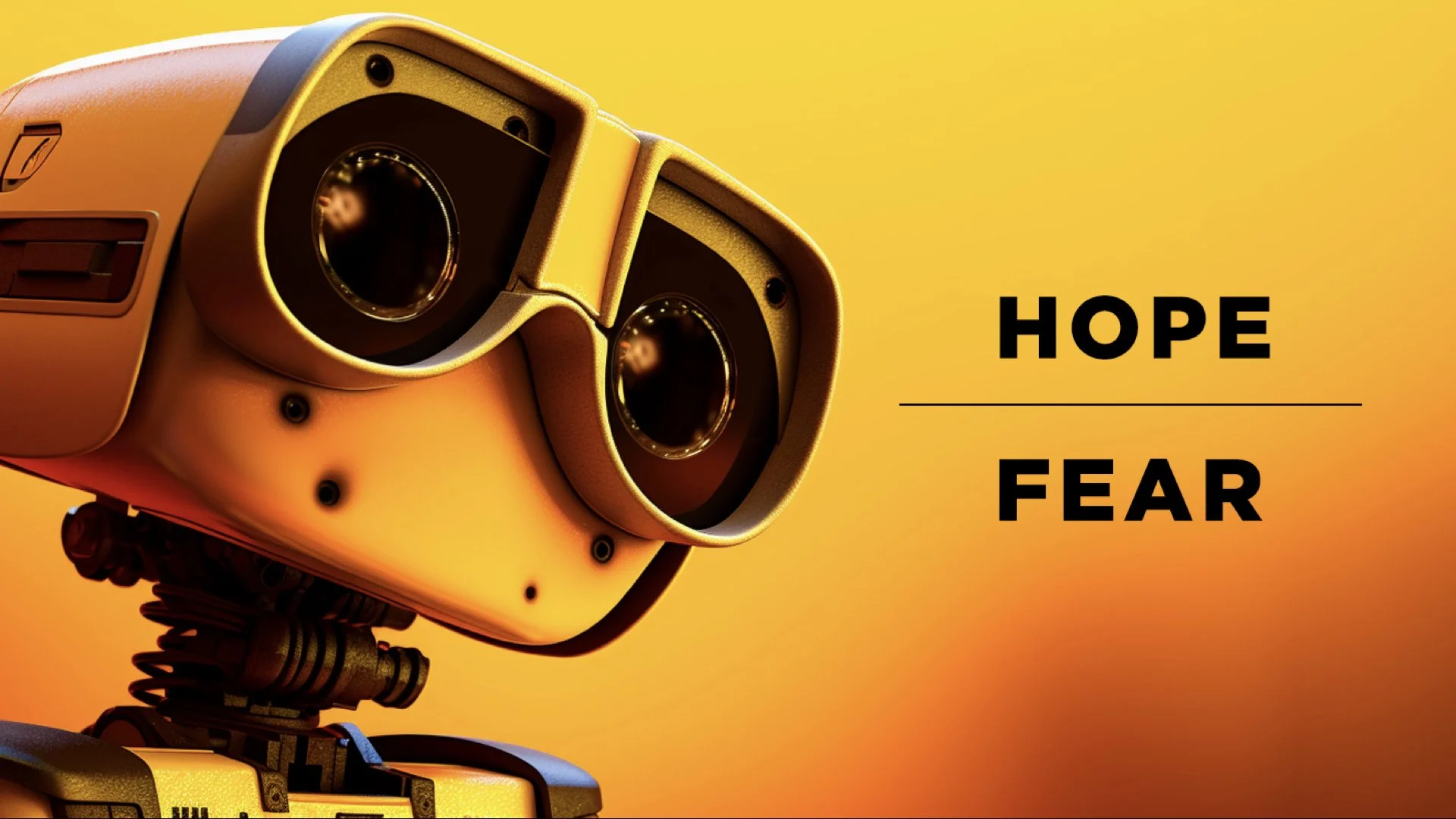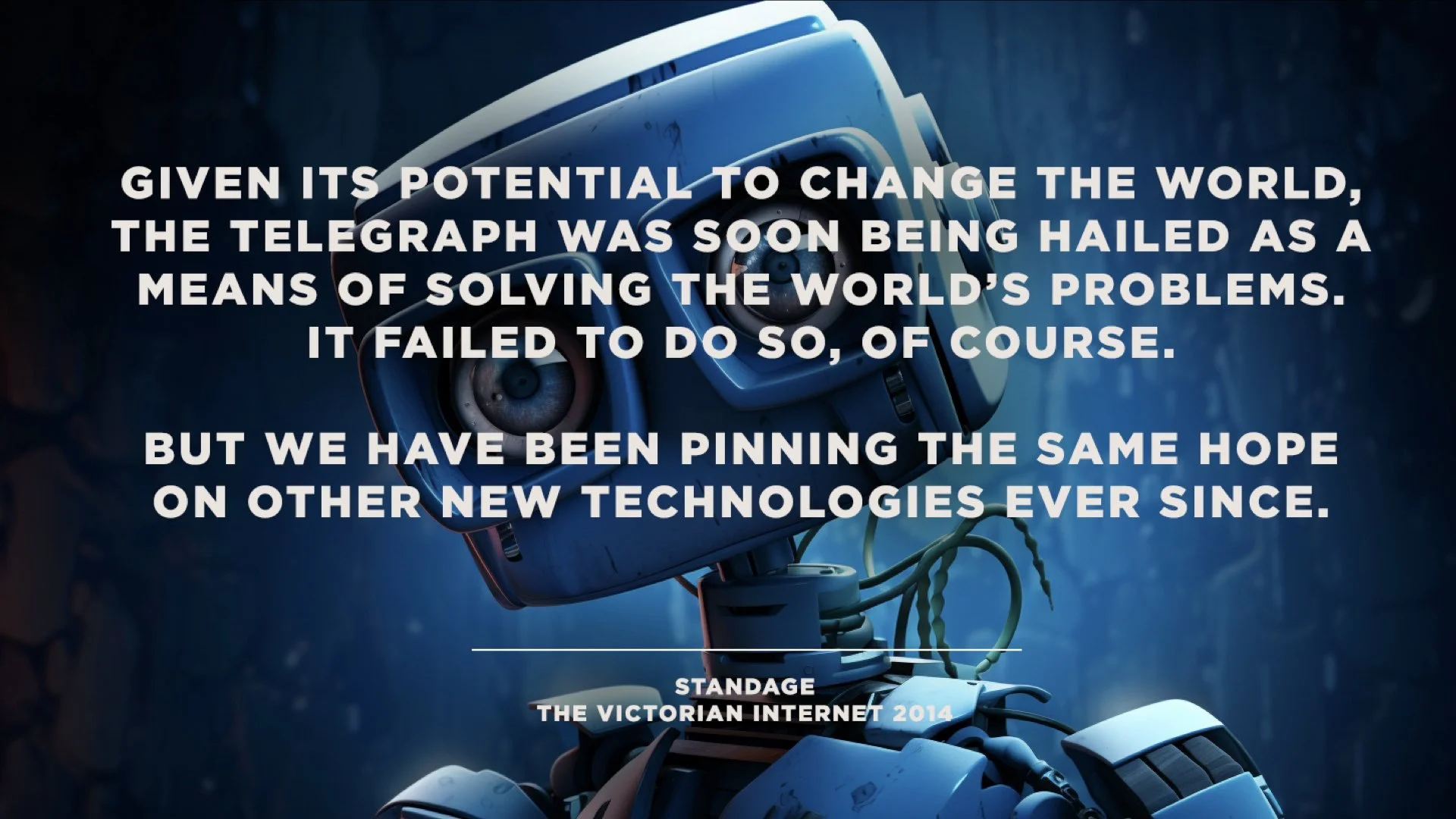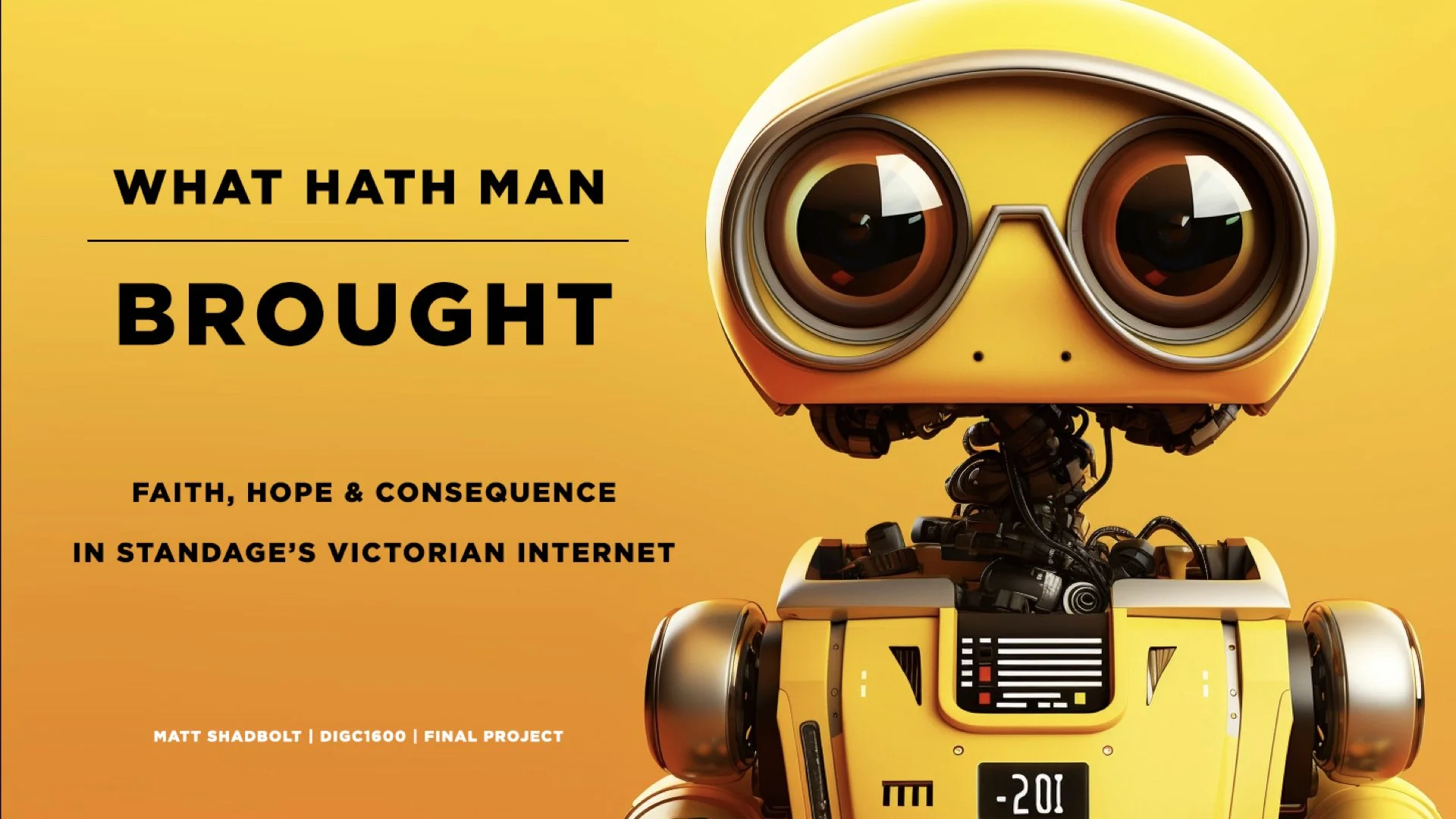DIGC1600 Final Project: What Hath Man Brought
Narrated Video:
Production Images & Animations:
Script:
Introduction: What God Hath Wrought
Technology is often the most human of tools. It motivates faith and hope in our human aspirations for it to unite, while also bringing consequence in its all-too-human unintended use. Over time these behaviors repeat themselves as cultural patterns and echoes, transforming into ritual as we endeavor to make sense of the world around and between us. Tom Standage’s book The Victorian Internet helps draw the highly relevant line between human exuberance and technological concern (Standage, 2014). Through the promise and innovation brought by the invention and legacy of the telegraph, through the hopes held for social media at the time of his writing in 2014, and to our current cautious embrace of generative artificial intelligence in 2024.
As Standage describes, technology has always motivated changes in communication between humans and across cultures, often innovating on the expediency of words between people. Since his book was published, the velocity by which we understand the world continues to accelerate in our digital culture, often beyond our comprehension (Standage, 2014). The volume of information, and our ability to make sense of it all, forces us to lean on devices of metaphor and faith in order to parse what is worth our attention. The gaming and weaponization of this attention itself is central to digital currency (Cain Miller & Sengupta, 2012). But for as much sense-making as we may be able to achieve, Standage also reinforces a ritual of comprehension where we cannot understand the ways in which technology is re-shaping cultural norms while still living through them. And when this happens, we often lean back on assumptions of hope and fear in order to look to the past and the future in trying to make sense of our present.
The Promise Brought: Benefits & Bridges
New technology often acts as a calamine to existing human problems, reflecting our deep faith in the ideas of conflict resolution, cultural prosperity and harmony across difference. And we embrace new technologies through this lens of faith and hope. As Standage explains, aspirational cultural benefits of unification and the exuberance brought by collapsing time and space is a ritual of hope which was present during the growth of the telegraph (Standage, 2014), but also appears in the embrace of social media, through to our still tentative adoption of artificial intelligence. Standage leans on Victorian testimony which could easily have been written today.
As he describes of the faith placed in the telegraph, ‘The Atlantic is dried up, and we become in reality as well as in wish, one country. The Atlantic Telegraph has half undone the Declaration of 1776 and has gone far to make us once again, in spite of ourselves, one people.’ (Standage, 2014, p.83) With strong echoes of Facebook’s mission to ‘make the world more open and connected’ (Cain Miller & Sengupta, 2012), the drawing together of people online in aspiration to foster greater common understanding would have been concurrent with Standage’s writing in 2014.
In a conference speech in November 1997, Nicholas Negroponte, then head of the MIT Media Laboratory, explicitly declared that the Internet would break down national borders and lead to world peace. In the future, he claimed, children ‘are not going to know what nationalism is’ (Negroponte in Reuters, 1997).
Assumptions of faith that a more connected, unified world is a source of good, repeat over time. We place faith in such technologies we hope will expedite positive economic and cultural outcomes. Those which aspire to generate common sympathies to human problems. As Standage finds in Victorian hope, ‘it is impossible that old prejudices and hostilities should longer exist, which such an instrument has been created for the exchange of thought between all the nation of the earth’ (Standage, 2014, p.83). We look to our tools to end suffering, drive prosperity and reduce conflict. But for whom?
The Consequence Wrought: Privacy & Price
But all hope and aspiration comes with a price. And we also understand technological innovation as a ritual of consequence and metaphor within these repeated conflicting cultural practices. This technological consequence is wrought by the unintended outcomes inherent in making assumptions, however aspirational (Bell, 2010). Consequence acts as a valve on the exuberance of technology. The New York Times in 1876 wrote of the fears brought by the innovation of the telephone, saying ‘by bringing music and ministers into every home, will empty the concert-halls and the churches. …
It is an unpleasant task to point out a possibly sinister purpose on the part of an inventor of conceded genius and ostensibly benevolent intentions. Nevertheless, a patriotic regard for the success of our approaching Centennial celebration renders it necessary to warn the managers of the Philadelphia exhibition that the telephone may really be a device of the enemies of the Republic.’ (Unknown Author, 1876).
Consequences of increased connectivity have brought and still bring, fears of the erosion of human agency and privacy, fraudulent behavior, and criminal activity (Bell, 2010). Behaviors which span the abuse of the telegraph, but also the concerns now more visible with social media and our future-oriented fears of the robots taking over in generative artificial intelligence.
As Standage describes, the weaponization of platforms by bad actors for economic and political outcomes isn’t anything new (Standage, 2014), but as a ritual counterpoint to our aspirations, these consequences keep our faith in check, and surface deeply human fears about the price of such innovation. They prompt us to ask if the hopeful value exchange is equitable, and what is being sold (Bilton, 2016). The data-harvested price of engagement and habituation in social media’s attention economics help us understand that when the product appears free, it is we who are the product.
Conclusion: What Man Hath Brought
The faith which humans place their hopes in technology is often challenged by the ritual of unintended consequence in its all-too-human use. All innovation comes with a price, but it is up to us to understand if the exchange is worth it. Standage’s work articulates our cultural understanding of technology through rising and falling rituals of hope and consequence through the innovation of the telegraph, but also gives us pause for what what happening in 2014 at the time of his writing. Social media’s assumption that a more connected, unified world is a source of good is repeated over time, and still repeats itself in 2024. Standage links together cultural aspects of technological aspiration and fear between the Victorian era and our own, but also extends it towards the future as a pattern of behavior we now see in generative artificial intelligence.
As Standage concludes, ‘The similarities between the telegraph and the Internet - both in their technical underpinnings and their social impact - are striking. But the story of the telegraph contains a deeper lesson. Because of its ability to link distant peoples, the telegraph was the first technology to be seized upon as a panacea. Given its potential to change the world, the telegraph was soon being hailed as a means of solving the world’s problems. It failed to do so, of course - but we have been pinning the same hope on other new technologies ever since.’ (Standage, 2014, p.210).
Standage’s Victorian Internet is worth reading in 2024 because it reflects a deeply human ritual of technological hope and consequence which has exuberantly repeated itself from the invention of the telegraph in the 1800s, through the rise of social media in the early 2000s at the time of his writing, and continues in 2024 with hopes we place in generative artificial intelligence.
References:
Bell, V. (2010). Don’t Touch That Dial! A history of media technology scares, from the printing press to Facebook. Slate.com. Retrieved from: https://slate.com/technology/2010/02/a-history-of-media-technology-scares-from-the-printing-press-to-facebook.html.
Bilton, N. (2016). Why Vinyl Records and Other ‘Old’ Technologies Die Hard. The New York Times. Retrieved from: https://www.nytimes.com/2016/03/16/style/vinyl-records-books-film-cameras-die-hard.html.
Cain Miller, C. & Sengupta, S. (2012). ‘Social Mission’ Vision Meets Wall Street. NYTimes.com. Retrieved from: https://www.nytimes.com/2012/02/02/technology/social-mission-vision-meets-wall-street.html.
Reuters, Unknown Author. (1997). Negroponte: Internet is way to world peace. CNN.com. Retrieved from: http://www.cnn.com/TECH/9711/25/internet.peace.reut/.
Standage, T. (2014). The Victorian Internet: The Remarkable Story of the Telegraph and the Nineteenth Century's On-line Pioneers. Bloomsbury USA.
The New York Times, Unknown Author. (1876). March 22, 1876, The New York Times. Retrieved from: https://timesmachine.nytimes.com/timesmachine/1876/03/22/issue.html.
Generative Statement:
No generative writing tools were used to create this script.
Generative creative tools MidJourney and RunwayML were used to create the animated visual components of this assignment.
The work was assembled in Apple Keynote, narration recorded using the Apple Quicktime Player, and composited in Adobe Photoshop and Adobe After Effects. The assignment is distributed via YouTube.
The font family used throughout is Gotham.


